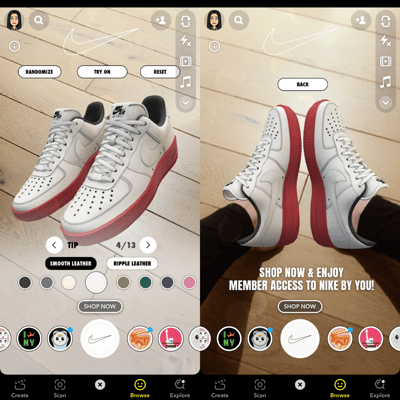10 RETAIL TRENDS TO WATCH IN 2024

10 RETAIL TRENDS TO WATCH IN 2024
As 2023 comes to a close, it's high time to consider what the next 12 months will bring. The retail landscape continues to evolve rapidly, and between the latest tech advancements (hello, AI) and shifting consumer behaviors, it's more important than ever to adapt.
But what exactly are you adapting to?
In this article, we'll explore the top retail trends shaping the industry in 2024. We'll also discuss how retailers can adapt to these trends and stay ahead of the curve.
10. EXPECT THE CONTINUED SUCCESS OF OMNICHANNEL RETAIL
Customers today want the ability to shop seamlessly online, in-store, and on mobile devices, and they expect to find the same products, prices, and promotions regardless of where they shop.
To that end, retailers that successfully implement omnichannel strategies will thrive in the coming year. This can be done by connecting all of your systems and data (sales, inventory levels, etc.) so that customers can see the same information, products, and promotions regardless of whether they're shopping online, in-store, or on their mobile devices.
In some cases, retailers may also use technology to show real-time inventory from all channels in-store. That way, customers can see whether a product is in stock online, in their local store, or a nearby location.
Target, for example, has effectively implemented this strategy by integrating its online and in-store systems. Customers can quickly check product availability online and on mobile to confirm whether an item is in stock before ordering or heading to a store.

9. WE'LL SEE MORE "THROWBACKS," PARTICULARLY IN APPAREL AND ACCESSORIES
In-store merchandising in 2024 will reflect trends from the 90s and 2000s (much to the chagrin of millennials). This shouldn't come as a surprise; fashion, after all, is cyclical, and we're at a time when the Y2K trends are making a comeback.
People are turning to social media to express their nostalgia and share their amusement at seeing these styles return.
For example, Tiktok user @harkeofficial went viral when she captured her visit to Target, highlighting the women's apparel section's throwback to late 90s and early 2000s fashion. The video showcased a resurgence of classic trends, from patent leather platform heels to spaghetti strap dresses, and even floral bucket hats and bejeweled belts, all making a stylish comeback.
On TikTok, the hashtag #90sfashion has over 1.7 billion views, while the hashtag #Y2Kfashion has over 2.6 billion views.
@jennaabarclay Or maybe moving to Australia in the witness protection program #y2k #y2kstyle #y2kaesthetic #marykateandashley ♬ Sugar - Stretch Princess
The massive engagement of these hashtags not only reflects a fondness for past styles. They can also guide the direction of retail strategies. Brands that embrace this trend and incorporate it into their in-store merchandising strategies are well-positioned to capture the attention of fashion-conscious consumers and drive sales in 2024 and beyond.
8. IN-STORE DISPLAYS WILL BE USED NOT JUST TO DRIVE SALES, BUT TO INCREASE SOCIAL ENGAGEMENT
Traditionally, retail displays (including window displays and in-store merchandising) have been used to drive traffic and sales in the store location itself. However, the rise of social media has opened up new possibilities for retail displays.
In addition to enticing customers to explore the store, they're also used to drive social media engagement. The rise of "Instagrammable" displays has encouraged shoppers to take photos and share them on their social media channels.
Take, for example, Tiffany & Co. The luxury jeweler's window displays, especially during the holiday season, are often elaborate and whimsical, drawing shoppers to take pictures and share them on social media.
7. EXPECT THE RISE OF INTERACTIVE MERCHANDISING EXPERIENCES
Forward-thinking brands will infuse technology into traditional displays. Think: touch-sensitive surfaces or augmented reality displays. These technologies can create a more immersive and interactive shopping experience, enhancing customer engagement and making the shopping journey more memorable.
For example, a touch-sensitive surface allows shoppers to explore products in more detail or view personalization options.
We saw this in action when Dior launched a satellite pop-up store in Soho. The store featured a wooden counter with a touchscreen display that enabled shoppers to customize their My ABCDior bags. The touch screen showed a variety of colors, patterns, and embellishments that shoppers could choose from to create a personalized bag.

6. SUSTAINABILITY WILL BE AN EVEN BIGGER FOCUS FOR CONSUMERS AND BRANDS
"The conscious consumer is no longer a niche segment. By 2024, demand for eco-friendly and ethically produced products will skyrocket," says Tang.
Industry data supports this. According to McKinsey & Company, over 60% of consumers would pay more for a product with sustainable packaging. The McKinsey article above also cites research by NielsenIQ, revealing that 78% of consumers say a sustainable lifestyle is important.
Nako Cosmetics has also seen the rewards of implementing sustainable initiatives. "Nako's commitment to sustainable packaging and cruelty-free testing saw our brand loyalty index improve by 40% in 2023," explains Tang.
She adds, "Businesses aiming to thrive should ensure transparent supply chains, prioritize sustainable practices, and communicate their ethical commitments clearly to consumers."
5. COMMUNITY-CENTRIC RETAILERS WILL FLOURISH
We expect short-term retailing—specifically in the form of pop-up stores—to gain even more traction in 2024.
With shoppers seeking out unique and memorable shopping experiences, pop-ups are an excellent tool for creating novel and engaging encounters. And because of their limited time availability, pop-ups often create a "now or never" mentality, which drives foot traffic.
In addition, pop-up stores allow brands to experiment with locations and concepts without long-term commitments, which means they can test market trends, consumer preferences, and new products in a real-world setting with minimal risk and investment.
4. COMMUNITY-CENTRIC RETAILERS WILL FLOURISH
There are several reasons why community-centric retail will continue to rise in 2024.
For one, consumers today are increasingly seeking authentic, meaningful experiences when they shop. Research shows that 88% of consumers consider authenticity as an important factor when deciding which brands to support.
Not only that but there's a growing desire among shoppers to support local stores. According to a survey by Intuit, almost two-thirds (62%) of consumers want to shop at local businesses.
All this is to say that community-centric retail is here to stay and is a movement you should capitalize on.
Meaghan Brophy, a Retail Expert at Fit Small Business, recommends taking a hyperlocal approach.
"Implement a microlocalization strategy by tailoring product assortments to the specific tastes and preferences of different neighborhoods," advises Brophy.
Another idea, she says, is to "Partner with local artisans or businesses to create exclusive products or services that resonate with the community, leveraging consumers' inclination towards supporting local businesses."
These steps enable you to tap into the growing consumer demand for authenticity and community support. This, in turn, helps you build stronger relationships with your customers and differentiate your brand.
3. INCREASED DTC PRESENCE IN RETAIL STORES
As the direct-to-consumer (DTC) market becomes even more competitive, brands will embrace brick-and-mortar retail as a channel for reaching shoppers.
For instance, the DTC mattress company Casper opened over 50 physical stores in North America. Similarly, the athleisure brand Outdoor Voice opened 20+ brick-and-mortar locations in the US.
These moves acknowledge the enduring value of physical stores—particularly when creating tangible brand experiences and connecting with customers on a personal level.
We don't expect this trend to slow down anytime soon, and in 2024, more DTC brands will likely double down on their physical presence.
2. INCREASING USE CASES OF AI IN RETAIL
Since this is an article focusing heavily on retail trends, we'd be remiss if we didn't talk about artificial intelligence (AI) and conversational commerce. While the technology has been around for quite some time, the rise of more mainstream solutions like ChatGPT propelled AI to the forefront of innovation.
Everyone from retail brands to online marketplaces are doubling down on their AI efforts. Instacart, for example, launched a ChatGPT plugin to power its virtual shopping assistant. Meanwhile, Walmart is developing its own AI language models to bolster its supply chain.
Some companies are using AI to improve personalization. Nako Cosmetics, a private-label cosmetics manufacturer, is leveraging the technology to create bespoke customer experiences.
"The rise of data analytics and AI means retailers can provide more tailored shopping experiences than ever before. At Nako, we've begun leveraging AI-driven insights to curate personalized product suggestions," remarks founder Sophia Tang.
"For instance, by analyzing purchase histories and skin type inputs, our online platform offers bespoke skincare routines. In a recent pilot program, this hyper-personalization led to a 28% uptick in repeat purchases and a 15% increase in average order value."
1. EXPECT THE CONTINUED RISE OF EXPERIENTIAL RETAIL
Forward-thinking retailers recognize that they simply cannot compete on price or product alone. With the rise of ecommerce and the increasing availability of products from various other sources, brands today must compete on experience. As Jon Morgan, CEO of Venture Smarter, puts it, "Shoppers are not just looking to buy products; they crave memorable experiences."
In other words, you must give customers something they can't find anywhere else. And for many merchants, this means diving into experiential retail. Take, for instance, Nike, which uses AR to create unique shoe trial experiences. In some of its stores, customers can use a smartphone app to see how different sneaker styles would look on their feet.
Of course, unique retail experiences aren't always rooted in technology. Trader Joe's, for example, is known for its friendly and community-centric store atmosphere, offering a warm and engaging shopping experience thanks to its empowered sales associates.
The key is figuring out the types of retail experiences your specific customers value and finding ways to deliver them in-store.

We expect the retail landscape 2024 to be more dynamic and customer-centric than ever. To navigate these trends, it's crucial to adapt and innovate continuously. Equipping your teams with the right technology is also a must.
Follow IWD on Facebook, LinkedIn, and Instagram or subscribe to our newsletter.




.png?width=330&name=COVER%20PAGE%20(1).png)
